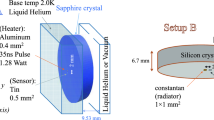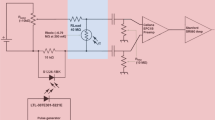Abstract
Even when care is taken to lower as much as possible the Joule power dissipated in a bolometric detector, the self-heating effect is far from being negligible. Consequently, in the steady state, it is of crucial importance to carefully distinguish the cell temperature, the bolometer temperature and the temperature of the part of the helium film which covers it. In the light of these results, when a bolometer is used to measure a small change in a thermal heat flux, the fundamental question concerns the exact definition of the quantity measured by the detector. To illustrate this problem we have considered the amplitude measurement of the third sound temperature oscillation. When the bolometer is operated from a current source, a detailed analysis of the different heat fluxes involved in the problem, provides a relation between the quantity usually measured in the experiments, and the real amplitude of the third sound temperature oscillation: Clearly these two values are noticeably different. Experimental measurements performed at 0.3 K support very well our analysis. Finally we show that a constant temperature bolometer appears much more suited to this kind of measurements.
Similar content being viewed by others
REFERENCES
R. A. Sherlock and A. F. G. Wyatt, J. Phys. E. Sci. Instrum. 16, 669 (1983).
V. E. Holt, J. Appl. Phys. 37, 798 (1966); E. T. Swartz, Ph.D. thesis, Cornell University (1987).
J. Helfrich, M. P. Maley, and M. Krusius, Phys. Rev. B 42, 2003 (1990); J. Helfrich, M. P. Maley, M. Krusius, and J. C. Wheatley, Phys. Rev. B 34, 6550 (1986).
J. P. Romagnan, J. C. Noiray, and J. P. Laheurte, J. Low Temp. Phys. 113, 43 (1998).
K. R. Atkins, Phys. Rev. 113, 962 (1959).
J. D. Bergman, Phys. Rev. 118, 370 (1969); J. P. Laheurte, J. C. Noiray, and J. P. Romagnan, J. Low Temp. Phys. 90, 451 (1993).
R. A. Sherlock and A. F. G. Wyatt, J. Phys. E. Sci. Instrum. 16, 673 (1983).
A. F. G. Wyatt, Phys. Rev. Lett. 69, 1785 (1992); T. W. Bradshaw and A. F. G. Wyatt, J. Phys. C 16, 651 (1983).
J. S. Brooks, F. M. Ellis, and R. B. Hallock, Phys. Rev. Lett. 40, 240 (1978).
J. P. Laheurte, J. C. Noiray, G. Rouillé, and J. P. Romagnan, Phys. Rev. B 43, 12837 (1991).
This cooling is anolog to the rarefaction in ordinary sound, which develops in the trailing end of an initially wholly positive pressure pulse. See Lord Raileigh, Theory of Sound, Vol. 2 (1929), p. 101.
Author information
Authors and Affiliations
Rights and permissions
About this article
Cite this article
Romagnan, J.P., Noiray, J.C. & Laheurte, J.P. The Effect of Self-Heating on the Measurement of a Temperature Change Using a Bolometric Detector. Journal of Low Temperature Physics 115, 281–290 (1999). https://doi.org/10.1023/A:1021831604502
Issue Date:
DOI: https://doi.org/10.1023/A:1021831604502




